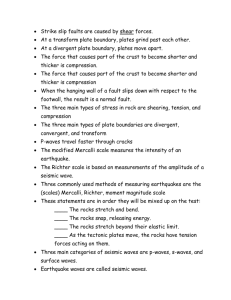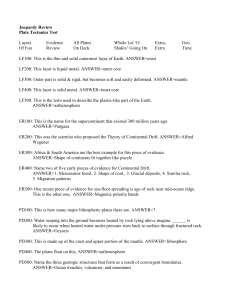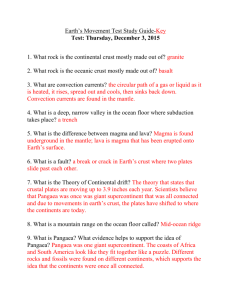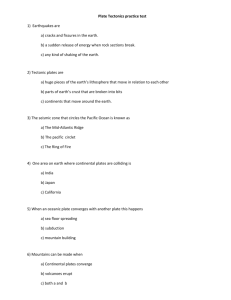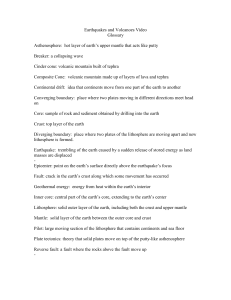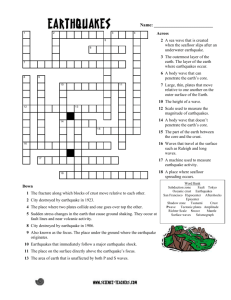Name
advertisement
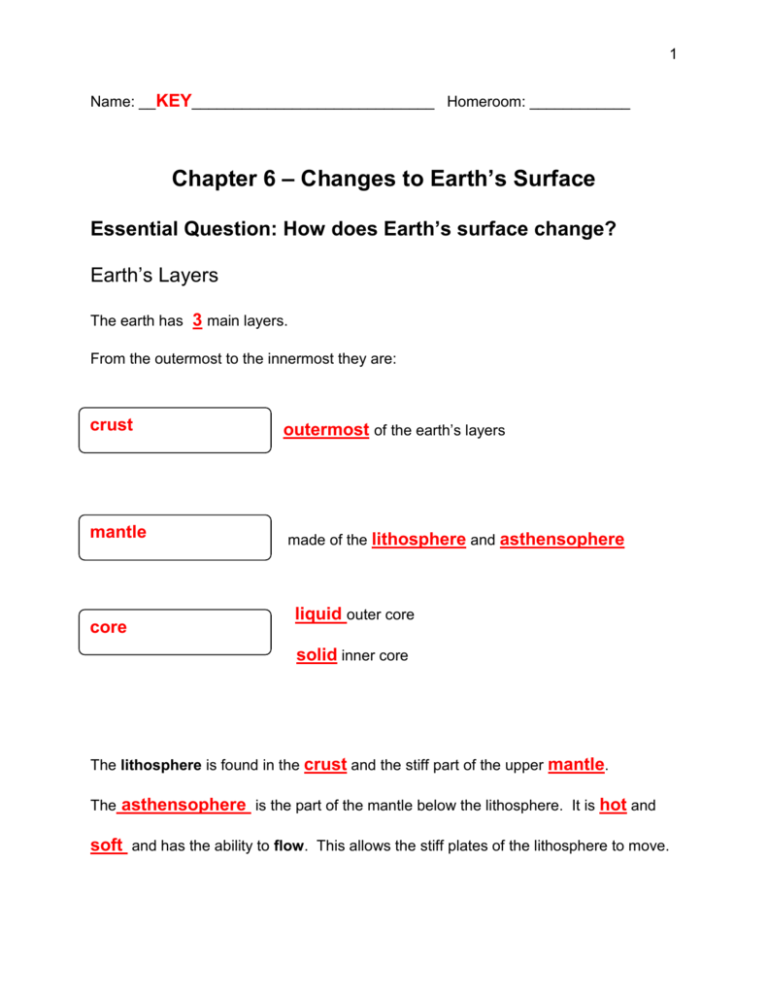
1 Name: __KEY_____________________________ Homeroom: ____________ Chapter 6 – Changes to Earth’s Surface Essential Question: How does Earth’s surface change? Earth’s Layers The earth has 3 main layers. From the outermost to the innermost they are: crust mantle core outermost of the earth’s layers made of the lithosphere and asthensophere liquid outer core solid inner core The lithosphere is found in the crust and the stiff part of the upper mantle. The asthensophere is the part of the mantle below the lithosphere. It is hot and soft and has the ability to flow. This allows the stiff plates of the lithosphere to move. 2 Wind, Water, and Gravity Change Earth’s Surface The crust of the Earth is constantly changing This happens because of movements of the mantle or sometimes by conditions on the Earth’s surface. Three of the processes are: weathering: the process of being broken down into smaller pieces erosion: the removal or transportation of weathered material deposition : the dropping or settling of eroded material Ice Changes Earth’s Surface Ice, frozen water, changes Earth’s surface too. Parts of the world have environments that are cold enough for glaciers: immense sheets of slow moving ice. Glaciers do not stay in one spot, instead they move slowly. Smaller glaciers might be found in a mountain valley. These glaciers typically travel slowly downhill and are called Alpine Glaciers. Continental Glaciers are much larger and several together can even cover a whole continent, such as Antartica. While glaciers move they carry rock, debris, and sediment along with them. This smoothes out the landscape and erodes small hills and other sharp features. At times glaciers are so heavy that they push down the land they are flowing over. Once the glacier moves away, the land it was covering rises back through a process called uplift. 3 Impacts Change Earth’s Surface The Earth’s surface is built up by a process of deposition by wind, water, gravity, and glaciers. The process of erosion wears down the Earth’s surface. This can be caused by wind, water, or glaciers, or an impact by a meteorite . Essential Question: What are plates and how do they move? Earth’s Plates The lithosphere is made up of many plates of rock. These plates fit together like a puzzle, but the plates are always moving. The continents are always moving too! The rock of the mantle is solid, but flows similar to taffy. Since the mantle flows the plates of the lithosphere can move. The theory that the lithosphere is divided into plates that are always moving is called plate tectonics. The lithosphere does not move quickly. In most places it only moves a few centimeters a year. However over many years the movement can cause major changes in the plates. Plate Boundaries There are three main types of plate boundaries. A divergent boundary is where two or more plates are moving away from each other. A transform fault boundary is when two plates move past each other. Two plates moving toward each other is known as a convergent boundary. 4 At times a chain of mountains beneath the ocean floor called a mid ocean ridge meet at a divergent boundary. The plates then move apart and hot rock moves up from the mantle. The melted rock cools and freezes, creating a new crust. The crust and mantel near the bottom of the ocean become rigid and form a new litosphere. This process along the mid-ocean ridge is called sea-floor spreading. Plate Movements Change Earth’s Surface 220 million years ago all of the continents were one single super continent which scientists call Pangea. Today the continents are still moving and the oceans are still changing size. If this continues the Earth’s surface will look different in another 200 million years. Essential Question: What causes earthquakes and volcanoes? Earthquakes Under pressure Earth’s plates bend. If the pressure is great the rock that makes up the plates break. A fault is formed when the rock breaks. A fault is a break in the Earth’s crust where rocks move past each other. The pressure is most great along plate boundaries therefore faults form at plate boundaries most often. Faults can also form within plates. When the Earth’s plates move pressure builds up along the plates’ faults. Rock along the faults bends or stretches like a rubberband If the rock stretches too far it will snap. Energy will then be released while the rock on either side slides 5 past the other. This snap and slide of rock as energy is released in Earth’s crust is an earthquake. An earthquake can occur deep inside the crust or mantle or close to the Earth’s surface. The focus is the point inside Earth where the earthquake begins. The point on the Earth’s surface directly above the focus of an earthquake is the epicenter . The energy that is released once the Earthquake begins travels away from the focus in waves. The first waves to be detected are the fastest waves called the Primary waves, or P waves. P waves compress and expand the ground while they travel. Secondary waves are the second-fastest waves, and are also known as S waves. P and S waves travel from the focus through the Earth’s interior, but arrive at detection points at different times because they travel at different time. P and S waves are not the only waves. A surface wave travels along the Earth’s surface. Some surface waves shake the ground from side to side, while other surface waves roll across the land like ocean waves. Surface waves cause most of the damage that is done to buildings during an earthquake. Measuring Earthquake Strength and Damage A seismograph is used to detect an earthquake. It electronically measures and records the motion caused by the earthquake’s waves. This data can determine the location of the earthquake. 6 A seismograph can also calculate the strength of the earthquake. The Richter scale estimates the amount of energy released by the earthquake. A low magnitude on the Richter scale means the earthquake was minor, the higher the magnitude gets the stronger it was. The Richter scale and the moment magnitude scale measure the earthquake by its strength. While the Mercalli intensity scale measures the amount of damage that an earthquake causes. An earthquake beneath the ocean floor is known as a tsunami. The large wave formed by a tsunami can travel great distances and once it nears land can even reach heights of more than 30m / 100 ft high. The giant wall of water slams into the coast causing large amounts of damage. Volcanoes Volcanoes are mountains that are formed when molten rock is pushed to the surface and builds up. Most often volcanoes form along the Earth’s plates boundaries. There are three basic categories of volcanoes. The category of the volcano is determined by the type of volcanic eruption that formed it. Shield volcano – non-explosive eruptions, layer after layer of lava slowly builds up Cinder Cone volcano – violent volcanic eruptions, erode quickly Composite volcano - are a combination of non-explosive and explosive eruptions 7 Shield volcanoes and composite volcanoes may erupt on and off for as long as a million years. Hawaiian Volcanoes The Hawaiian Islands were formed thanks to a series of volcanoes. These volcanoes did not occur at plate boundaries, rather at a hot spot. Here the magma is less dense (thick); therefore it is able to be pushed towards the surface. If the magma erupts above the surface, a volcano is formed.
